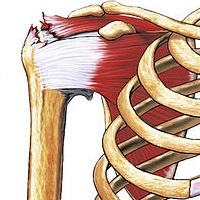
Photo from wikipedia
Shoulder disorders are common, with a reported prevalence ranging from 7% to 26% in adults.2 Rotator cuff disease is the most common cause of shoulder pain seen by physicians.3 About… Click to show full abstract
Shoulder disorders are common, with a reported prevalence ranging from 7% to 26% in adults.2 Rotator cuff disease is the most common cause of shoulder pain seen by physicians.3 About 40% of cases persist for longer than 1 year with rates of recurrence and chronicity of shoulder pain rated as moderate to high.2 Many people with shoulder pain do not experience a complete resolution of symptoms, and 51% reported recurrence after 26 weeks and 41% reported recurrence after 1218 months.4 There are different conservative approaches to relieve pain and restore movement and function of the shoulder. Extracorporeal shock wave therapy (ESWT) has been introduced for treating various musculoskeletal disorders, including chronic tendinopathies since the 1990s. Shock waves are single sonic pulses with a steep pressure rise, high peak pressure, short duration, followed by a low tensile amplitude.5,6 According to the energy flux density there are lowenergy shock waves (less than 0.1 mJ/mm2) and highenergy shock waves (0.2 mJ/mm20.4 mJ/mm2)7 Radial shock waves show a lower peak pressure, longer rise time and the focal point of energy is not centered on a target zone but on the tip of the applicator.57 The possible mechanism of their effect in tendinopathies is overstimulation of pain nerve fibers, the reduction of painconducting Cfibers, and induction of the healing process of the tendon.5 The new functional proteins induced by ESWT promote a chondroprotective effect, neovascularization, antiinflammation, antiapoptosis, and tissue and nerve regeneration.8
Journal Title: International Journal of Rheumatic Diseases
Year Published: 2021
Link to full text (if available)
Share on Social Media: Sign Up to like & get
recommendations!